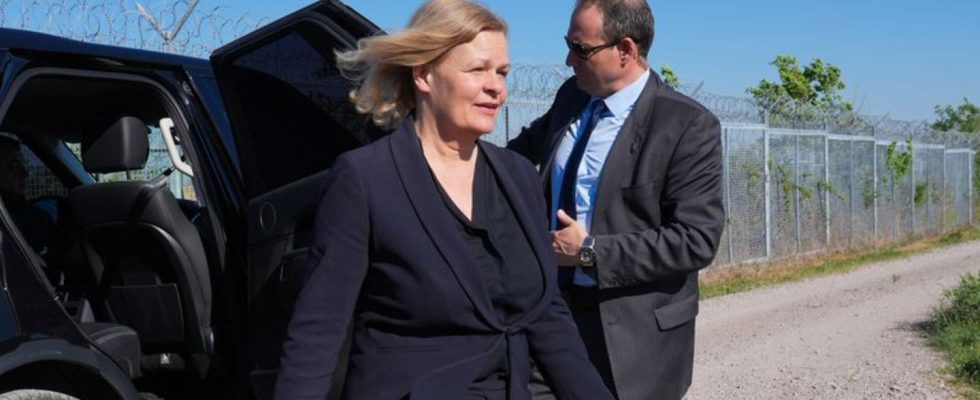It is the Federal Interior Minister’s first visit to an external border of the European Union. Asylum applications will be examined at these borders in the future. Faeser worked hard for this.
Five days after the EU asylum reform was passed in the European Parliament, Federal Interior Minister Nancy Faeser (SPD) visited Bulgaria to discuss questions about future EU external border protection. Upon her arrival in the southern Bulgarian city of Plovdiv, Faeser was welcomed by her counterpart, Interior Minister Kalin Stojanov, who then accompanied her to the Bulgarian-Turkish border.
The Kapitan Andreevo border crossing, which the politicians are visiting, is one of the places where it will be decided whether the compromise negotiated in Brussels will work in practice or not. A pilot project should be created here, says Faeser, to test how the new EU asylum rules are implemented.
“Averted attempts” or illegal “pushbacks”?
The 259-kilometer-long Bulgarian EU external border with Turkey on the mainland has been completely protected by a double barbed wire fence since 2017 and monitored with thermal imaging cameras. Nevertheless, migrants often cross it with the help of smugglers. The border guards that Faeser meets in Bulgaria explain that the aim is to gain time in order to be there in time and to prevent irregular border crossings.
The aim is to stop the many people who repeatedly put ladders on the fence between grain fields and bumpy dirt roads and place blankets over the barbed wire in order to climb over unhurt. It is said that sometimes tunnels are dug under the fence. This is about “prevented attempts”, not about illegal “pushbacks”, emphasizes the head of the Bulgarian border police, Anton Zlatanov.
Faeser’s long-planned visit to Bulgaria comes at a time when the southeastern European country is in a political crisis. Bulgaria has had a transitional government since last Tuesday and will elect a new parliament for the sixth time in three years on June 9th.
The number of asylum applications in Germany has recently fallen
According to the Federal Office for Migration and Refugees, 329,120 people in Germany applied for asylum for the first time in 2023, around 50 percent more than in the previous year. Most of them came from Syria, Turkey and Afghanistan. In the first quarter of this year, 65,419 initial applications were made, around 19 percent fewer than in the same period last year.
One reason for the decline is likely to be the stationary border controls at the borders with the Czech Republic, Poland and Switzerland, which Faeser ordered in mid-October. According to them, more than 700 smugglers have been arrested and 17,600 unauthorized entries have been prevented through border controls.
According to the EU border protection agency Frontex, fewer migrants have recently come into the European Union via the so-called Western Balkan route and the central Mediterranean. At the same time, the number of arrivals via the eastern and western Mediterranean routes has increased.
Bulgaria joined the Schengen area on March 31, but only with freedom from air and sea border controls. There is no timetable for the introduction of the Schengen rules at land borders. Faeser says that Bulgaria has met the necessary criteria, so it would be “consequent” to fully apply the Schengen rules. This is well received by your host.
Preparations for new EU asylum borders should be made quickly
Preparations should now be made at the EU’s external borders so that the rules of the reform of the Common European Asylum System, which was decided after years of dispute, take effect in two years at the latest. The reform stipulates, among other things, that asylum applications from people from countries of origin with an EU-wide recognition rate of less than 20 percent are already examined in reception camps at the external borders.
Such an asylum center is being prepared as a pilot project in Bulgaria financed by the EU Commission, says Faeser. Asked about reports that migrants coming to Bulgaria from Turkey are being sent back and beaten, the Bulgarian Interior Minister said these were “isolated isolated cases”. The problem has largely been solved. Faeser emphasizes that the deployment of Frontex is important to her. The EU border protection agency ensures that “action is carried out in accordance with the rule of law”.
Some of the new EU regulations adopted apply immediately. In order to implement the new EU asylum guidelines, national laws in the member states will soon have to be changed.
Faeser has planned talks for Tuesday in Romania, whose government recently boasted of having greatly curbed irregular migration across the Serbian-Romanian border. The border guards operate there with night vision devices, thermal imaging cameras and drones. There is no fence there.

